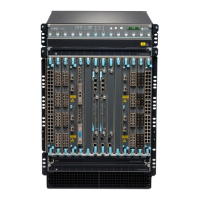installaon torque to the nuts when they are improperly threaded can damage the
terminal stud.
CAUTION: The maximum torque rang for the terminal studs on the DC power
supply is 36 lb-in. (4.0 Nm) Excessive torque can damage the terminal studs. Use
only a torque-controlled driver or socket wrench to ghten the nuts on the DC
power supply terminals.)
10. Route the power cables along the cable restraint toward the le or right corner of the chassis. If
needed, thread plasc cable es, which you must provide, through the openings on the cable
restraint to hold the power cables in place.
11. Replace the clear plasc cover over the terminal studs on the faceplate.
12. Verify that the power cabling is correct, that the cables are not touching or blocking access to
switch components, and that they do not drape where people could trip on them.
13. Switch on the dedicated customer site circuit breakers. Follow your site's procedures for safety and
to prevent ESD damage (see
Prevenon of Electrostac Discharge Damage
).
NOTE: The DC power supplies in slots PEM0 and PEM1 must be powered by dedicated
power feeds derived from feed A and the DC power supplies in slots PEM2 and PEM3 must
be powered by dedicated power feeds derived from feed B. This conguraon provides the
commonly deployed A/B feed redundancy for the system. For informaon about connecng
to DC power sources, see "DC Power Supply Specicaons for EX9214 Switches" on page
54.
14. Verify that the INP0 OK or INP1 OK LED on the power supply are lit green steadily. If you are using
two feeds, verify that both INP0 OK and INP1 OK LEDs on the power supply are lit steadily in
green. The INP0 OK and INP1 OK LEDs are lit in amber color if the voltage at the input is in reverse
polarity. Check the polarity of the power cables to x the condion.
15. On each of the DC power supplies, switch the DC circuit breaker to the center posion before
moving it to the On (|) posion.
NOTE: The circuit breaker might bounce back to the O (O) posion if you move the
breaker too quickly.
183

